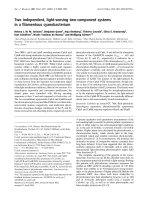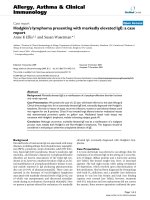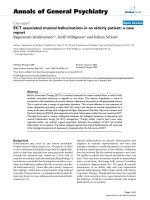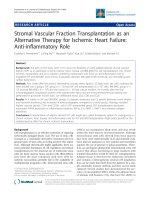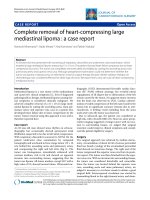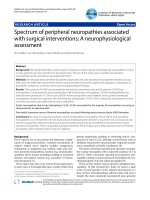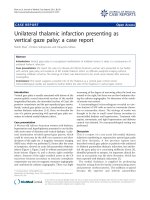Báo cáo y học: " Spontaneous idiopathic pneumoperitoneum presenting as an acute abdomen: a case repor" pot
Bạn đang xem bản rút gọn của tài liệu. Xem và tải ngay bản đầy đủ của tài liệu tại đây (615.51 KB, 4 trang )
CAS E REP O R T Open Access
Spontaneous idiopathic pneumoperitoneum
presenting as an acute abdomen: a case report
Michail Pitiakoudis
1
, Petros Zezos
2*
, Anastasia Oikonomou
3
, Michail Kirmanidis
1
, Georgios Kouklakis
2
,
Constantinos Simopoulos
1
Abstract
Introduction: Pneumoperitoneum is most commonly the result of a visceral perforation and usually presents with
signs of acute peritonitis requiring an urgent surgical intervention. Non-surgical spontaneous pneumoperitoneum
(not associated with a perforated viscus) is an uncommon entity related to intrathoracic, intra-abdominal,
gynecologic, iatrogenic and other miscellaneous causes, and is usually managed conservatively. Idiopathic
spontaneous pneumoperitoneum is an even more rare condition from which both perforation of an intra-
abdominal viscus and other known causes of free intraperitoneal gas have been excluded.
Case presentation: We present the case of an idiopathic spontaneous pneumoperitoneum. A 69-year-old Greek
woman presented with acute abdominal pain, fever and vomiting. Diffuse abdominal tenderness on deep
palpation without any other signs of peritonitis was found during physical examination, and laboratory
investigations revealed leukocytosis and intraperitoneal air below the diaphragm bilaterally. Her medical history was
unremarkable except for previous cholecystectomy and appendectomy. The patient did not take any medication,
and she was not a smoker or an alcohol consumer. Emergency laparotomy was performed, but no identifiable
cause was found. A remarkable improvement was noticed, and the patient was discharged on the seventh
postoperative day, although the cause of pneumoperitoneum remained obscure.
Conclusion: A thorough history and physical examination combined with the appropriate laboratory tests and
radiologic techniques ar e useful tools in identifying patients with non-surgical pneumoperitoneum and avoiding
unnecessary operations.
Introduction
Pneumoperitoneum is the result of a gastrointestinal
(GI) tract perforation in more than 90% of cases [1].
Perforation of the stomach or duodenum caused by pep-
tic ulcer is considered the most common cause of pneu-
moperitoneum. Pneumoperitoneum can also be the
result of a diverticular rupture or of an abdominal
trauma [1]. It commonly presents with signs and symp-
toms of peritonitis, and subphrenic free gas in an
upright chest radiograph is the most common radiologic
finding. In most cases, pneumoperitoneum requires
urgent surgical exploration and intervention [1].
However, sometimes pneumoperitoneum not asso-
ciated with a perforated viscus can occur; this is called
spontaneous pneumoperitoneum (SP) or “non-surgical”
pneumoperitoneum. SP is associated with intrathoracic,
intraabdominal, gynecologic, iatro genic or other miscel-
laneous causes [1]. Although it is not usually compli-
cated with peritonitis, SP is characterized by a benign
course and can be managed conservatively [1-4]. Idio-
pathic SP is an even more rare condition for which no
clear etiology has been established because both perfora-
tion of an intraabdominal viscus and other known
causes of free intraperitoneal gas have been excluded
[1,5-7]. Idiopathic pneumoperitoneum is usually diag-
nosed after negative laparotomy results. SP poses signifi-
cant management dilemmas for surgeons, espec ially
when signs of peritonitis are absent or when the cause
is unknown before laparotomy.
* Correspondence:
2
Gastrointestinal Endoscopy Unit, Democritus University of Thrace, University
General Hospital, 68100 Dragana Alexandroupolis, Greece
Full list of author information is available at the end of the article
Pitiakoudis et al. Journal of Medical Case Reports 2011, 5:86
/>JOURNAL OF MEDICAL
CASE REPORTS
© 2011 Pitiakoudis et al; licensee BioMed Central Ltd. Thi s is an Open Access article distributed under the terms of the Creative
Commons Attribution License ( which permits unrestricte d use, distribution, and
reproduction in any medium, provided the original work is properly cited.
Case presentation
A 69-year-old Greek female patient presented at our
emergency department (ED) with a two-hour history of
abdominal pain and vomiting. Her medical history was
unremarkable except for previous c holecystectomy and
appendectomy. The patient did not take any medica-
tions, and she was not a smoker or an alcohol
consumer.
She looked ill with a blood pressure of 130/85 mm/
Hg, a pulse rate of 90 b eats/min, respirations of 25
breaths/min and a temperature of 38.5°C. A thorough
physical examination revealed diffuse abdominal tender-
ness on deep palpation without any ot her signs of peri-
tonitis. The laboratory examination was unremarkable
except for polymorphonuclear leucocytosis (white blood
cell [WBC] count, 15 × 10
3
/μL; neutrophils, 86%) and
an elevated C-reactive protein (14 mg/dL; reference
range, 0-5). An upright chest radiograph demonstrated
free subdiaphragmatic air bil aterally (Figure 1), which
seemed to be increasing during air insufflation in the
stomach via a nasogastric tube (Figure 2). Abdominal
ultrasound examination was unremarkable.
An emergency laparotomy was performed for a sus-
pected perforation in the upper GI tract. A few adhe-
sions caused by previous cholecystectomy and
appendicectomy were observed without any signs of
peritoneal irritation or peritoneal fluid. The stomach
andduodenumwerefullymobilized,andthelessersac
was explored, but no evidence of perf oration was found
in the distal esophagus, stomach or duodenum. The
small bowel and colon were also examined, but no
leakage was observed. Subsequently, dilution of methy-
lene blue in normal saline was instilled into the stomach
through the nasogastric tube, but no obvious leakage
was noted. Afterward, the abdominal cavity was filled
with 2000 cc of normal saline, and air was again infused
through the nasogastric tube into the stomach, but no
air leakage f rom the upper GI tract was noted. Finally,
because no cause of the pneumoperitoneum had been
found, the operation was completed by placing a dou-
ble-lumen drain.
The postoperative course was uneventful, and t he
patient showed a significant and prompt recovery. The
subdiaphragmatic air disappeared six days postopera-
tively (Figure 3). The patient was discharged home on
the seventh postoperative day. One month later, esopha-
gogastroduodenoscopy, colonoscopy and abdominal
computed tomography (CT) were performed, but no
pathology was detected.
Discussion
SP is associated with intrathoracic, intraabdominal,
gynecologic, iatrogenic and other miscellaneous causes
[1,2]. SP has been attributed to several thoracic causes,
such as traumas (including barotraumas), pneumothorax
and bronchoperitoneal fistulas [1]. SP ca n be accompa-
nied by pneumomediastinum or pneumopericardium,
especially in patients who are on mechanical aspiration
and positive end-expirationpressure[1].Inextremely
rare cases, scuba diving and pulmonary sepsis can cause
SP. Pneumatosis cystoides intestinalis is the most com-
mon abdominal cause of nonsurgical pneumoperito-
neum [1]. Emphysematous cholecystitis, spontaneous
bacterial peritonitis, ruptured hepatic abscess and perfo-
rated pyometra in women are rare causes of SP [1].
Figure 1 Upright posteroanterior chest radiograph. There is free
subdiaphragmatic air bilaterally that is more clearly noted on the
right side (white arrows).
Figure 2 Upright posteroanterior chest radiograph after
insufflating air into the stomach. The free subdiaphragmatic air
has slightly increased in size bilaterally compared with Figure 1
(white arrows).
Pitiakoudis et al. Journal of Medical Case Reports 2011, 5:86
/>Page 2 of 4
In women, pneumoperitoneum after rough sexual inter-
course or after Jacuzzi usage has also been reported
because the air can also be transmitted to the peritoneal
cavity through the vagina and saplings [1]. Laparoscopic
or endoscopic procedures (colonoscopy) may cause
iatrogenic SP [1].
The cause of pneumoperitoneum and the clinical signs
determine its mode of treatment, surgical or not. When
signs and symptoms of “acute abdomen” are present,
surgical management is mandatory, but in cases of non-
surgical pneumoperitoneum with mild sympt oms and
without any signs of peritonitis, conservative treatment
is indicated [2].
A detailed history and physical examination can be
very helpful in distinguishing surgical from nonsurgical
pneumoperitone um, thus avoiding unnecessar y laparo-
tomies [2]. Moreover, radiographic imaging before and
after air insufflation into the gastric lumen via a naso-
gastric tube (pneumogastrogram) is an easy and safe
method, which can enhance or confirm the diagnosis of
a visceral perforation in the upper GI tract [8].
Plain chest or abdominal radiography is the most
common imaging exami nation for the diagnosis of even
very small amounts of intraperitoneal free air in the ED
setting [9], but ab dominal CT is a more sensitive
method of diagnosing pneumoperitoneum and ident ify-
ing the cause of “acute abdomen” [10,11]. Moreover,
modern technology with multidetector CT is highly
accurate for predicting the site of GI tract perforations
[12,13].
It has been proposed that in some cases with idio-
pathic pneumoperitoneum, a subclinical small visceral
perforation may have occurred, permitting only the leak-
age of air and not of bowel contents [1]. Finally, in other
cases, other unknown factors may be the cause of idio-
pathic pneumoperitoneum [1].
We report the case of a patient who underwent an
urgent but nondiagnostic exploratory l aparotomy,
although she had compelling evidence for a surgical
pneumoperitoneum. A minority of pneumoperitoneum
cases are considered idiopathic, but many of them
undergo surgical exploration [2]. van Gelder et al. [5]
reported six patients with pneumoperitoneum and clini-
cal signs of acute abdomen who underwent exploratory
laparotomy, which did not reveal any intraabdominal
pathology. Chandler et al. [14] reported a laparotomy
rate of 28% on nonsurgical pneumoperitoneum. In a
rev iew, Mularski et al. [15] found 196 reported cases of
nonsurgical pneumoperitoneum, of which 45 underwent
surgical exploration without evidence of perforated vis-
cus. Furthermore, Mularski et al. [15] reported that 11
of 36 (31%) miscellaneous or idiopathic cases of nonsur-
gical PP underwent surgical exploration.
Currently, laparoscopic exploration instead of laparot-
omy can be the operation of choice in cases of pneumo-
peritoneum because it can both determine and treat the
cause, offering all the advantages of minimally invasive
surgery.
Conclusion
A thorough history and physical examination combined
with the appropriate laboratory tests and radiologic
techniques are useful tools in identifying patients with
nonsurgical pneumoperitoneum and avoiding unneces-
sary operations.
Consent
Written informed consent was obtained from the patient
for the publication of this case report and the accompa-
nying images. A copy of the written consent is available
for review by the Editor-in-Chief of this journal.
List of abbreviations
CT: computed tomography; ED: emergency department; GI: gastrointestinal;
SP: spontaneous pneumoperitoneum; WBC: white blood cell.
Author details
1
Second Department of Surgery, Democritus University of Thrace, University
General Hospital, 68100 Dragana Alexandroupolis, Greece.
2
Gastrointestinal
Endoscopy Unit, Democritus University of Thrace, University General Hospital,
68100 Dragana Alexandroupolis, Greece.
3
Radiology Department, Democritus
University of Thrace, University General Hospital, 68100 Dragana
Alexandroupolis, Greece.
Authors’ contributions
MP participated in the patient’s treatment, had the idea for the case report,
contributed to the first draft and performed all of the revisions. PZ collected
the patient’s data, participated in the first draft and performed all of the
revisions. AO participated in the imaging diagnosis of the case and
contributed to the writing of the paper. MK participated in the patient’s
treatment and contributed to the writing of the paper. GK contributed to
the writing of the paper. CS participated in the patient’s treatment and
Figure 3 Upright posteroanterior chest radiograph just before
the patient’s discharge. No subdiaphragmatic free air is noted
bilaterally.
Pitiakoudis et al. Journal of Medical Case Reports 2011, 5:86
/>Page 3 of 4
participated in the final revision. All authors read and approved the final
manuscript.
Competing interests
The authors declare that they have no competing interests.
Received: 26 April 2010 Accepted: 27 February 2011
Published: 27 February 2011
References
1. Mularski RA, Ciccolo ML, Rappaport WD: Nonsurgical causes of
pneumoperitoneum. West J Med 1999, 170:41-46.
2. Karaman A, Demirbilek S, Akin M, Gürünlüoğlu K, IrşiC:Does
pneumoperitoneum always require laparotomy? Report of six cases and
review of the literature. Pediatr Surg Int 2005, 21:819-824.
3. Omori H, Asahi H, Inoue Y, Irinoda T, Saito K: Pneumoperitoneum without
perforation of the gastrointestinal tract. Dig Surg 2003, 20:334-338.
4. Eslick GD, Chalasani V, Salama AB: Idiopathic pneumoperitoneum. Eur J
Intern Med 2006, 17:141-143.
5. van Gelder HM, Allen KB, Renz B, Sherman R: Spontaneous
pneumoperitoneum. A surgical dilemma. Am Surg 1991, 57:151-156.
6. Fick TE, van Oorschot FH, Mallens WM, Kitslaar PJ: Pneumoperitoneum
without peritonitis. Neth J Surg 1988, 40 :152-154.
7. Breen ME, Dorfman M, Chan SB: Pneumoperitoneum without peritonitis:
a case report. Am J Emerg Med 2008, 26:841, e1-2.
8. Lee CW, Yip AW, Lam KH: Pneumogastrogram in the diagnosis of
perforated peptic ulcer. Aust N Z J Surg 1993, 63:459-461.
9. Chiu YH, Chen JD, Tiu CM, Chou YH, Yen DH, Huang CI, Chang CY:
Reappraisal of radiographic signs of pneumoperitoneum at emergency
department. Am J Emerg Med 2009, 27:320-327.
10. Stapakis JC, Thickman D: Diagnosis of pneumoperitoneum: abdominal CT
vs. upright chest film. J Comput Assist Tomogr 1992, 16:713-716.
11. Ng CS, Watson CJ, Palmer CR, See TC, Beharry NA, Housden BA, Bradley JA,
Dixon AK: Evaluation of early abdominopelvic computed tomography in
patients with acute abdominal pain of unknown cause: prospective
randomised study. BMJ 2002, 325:1387.
12. Hainaux B, Agneessens E, Bertinotti R, De Maertelaer V, Rubesova E,
Capelluto E, Moschopoulos C: Accuracy of MDCT in predicting site of
gastrointestinal tract perforation. AJR Am J Roentgenol 2006,
187:1179-1183.
13. Oguro S, Funabiki T, Hosoda K, Inoue Y, Yamane T, Sato M, Kitano M,
Jinzaki M: 64-Slice multidetector computed tomography evaluation of
gastrointestinal tract perforation site: detectability of direct findings in
upper and lower GI tract. Eur Radiol 2010, 20:1396-1403.
14. Chandler JG, Berk RN, Golden GT: Misleading pneumoperitoneum.
Surg
Gynecol Obstet 1977, 144:163-174.
15. Mularski RA, Sippel JM, Osborne ML: Pneumoperitoneum: a review of
nonsurgical causes. Crit Care Med 2000, 28:2638-2644.
doi:10.1186/1752-1947-5-86
Cite this article as: Pitiakoudis et al.: Spontaneous idiopathic
pneumoperitoneum presenting as an acute abdomen: a case report.
Journal of Medical Case Reports 2011 5:86.
Submit your next manuscript to BioMed Central
and take full advantage of:
• Convenient online submission
• Thorough peer review
• No space constraints or color figure charges
• Immediate publication on acceptance
• Inclusion in PubMed, CAS, Scopus and Google Scholar
• Research which is freely available for redistribution
Submit your manuscript at
www.biomedcentral.com/submit
Pitiakoudis et al. Journal of Medical Case Reports 2011, 5:86
/>Page 4 of 4
